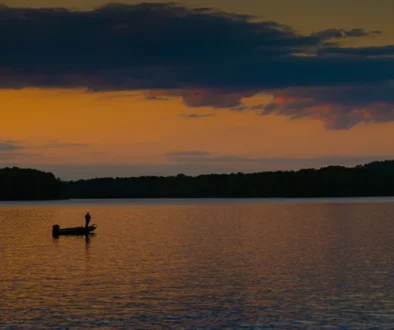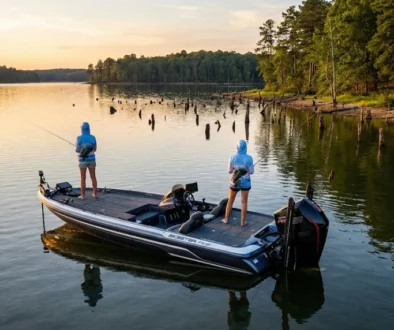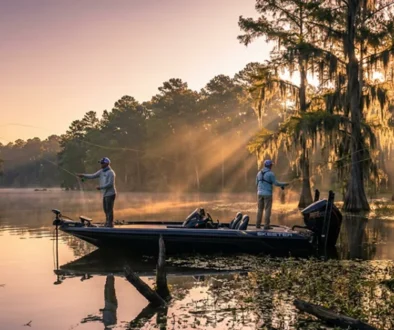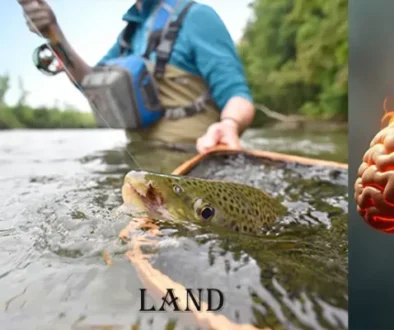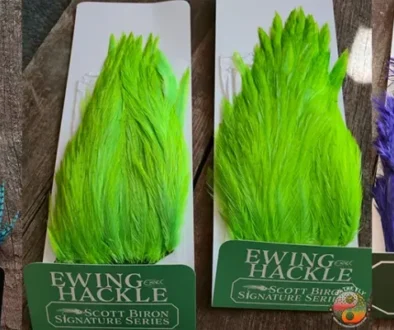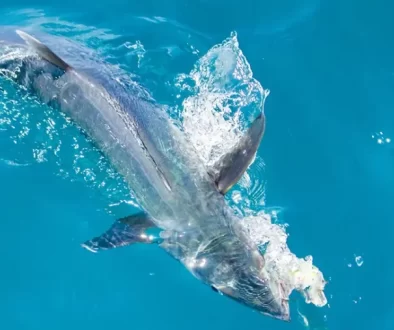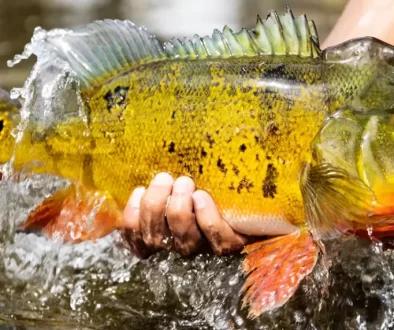Fly Fish Virginia for Trout, Bass, Muskie, and Coastal Striped Bass
So you’re set to fly fish Virginia for trout bass muskie and coastal striped bass, right? Picture yourself wading through the serene waters of Virginia’s rivers and streams. This state is a playground for anglers looking to hook into some serious game fish action.
With every cast, you’ve got a shot at reeling in anything from feisty smallmouths in the James River to elusive muskies lurking in the depths of the New. And let’s not forget those monster stripers patrolling the Chesapeake Bay. We’ll walk you through top fishing spots like Shenandoah National Park or Smith Mountain Lake, ensuring your next trip is nothing short of epic. Fly Fish Virginia, I think there slogan use to be Virginia is for lovers of Fly Fishing?
Pack up that fly rod; an unforgettable fishing experience awaits with trophy catches just waiting to strike your fly.
Table Of Contents:
- Fly Fishing in Virginia: An Angler’s Paradise
- Seasonal Strategies for Coastal Striped Bass Fly Fishing
- Seasonal Strategies for Coastal Striped Bass Fly Fishing
- Essential Gear for Fly Fishing Across Virginia
- Best Practices for Catch-and-Release Fishing
- Navigating Virginia’s Top Fly Fishing Destinations
- Regulations You Need to Know Before You Fly Fish Virginia
- Mastering Fly Fishing Techniques Tailored to Fly Fish Virginia
- Mastering Fly Fishing Techniques Tailored to Virginian Waters
- The Ethical Angler: Promoting Responsible Fishing Practices
- FAQs in Relation to Fly Fish Virginia for Trout Bass Muskie and Coastal Striped Bass
- Conclusion of Fly Fish Virginia
- Fly Fish Another State or Country
Fly Fishing in Virginia: An Angler’s Paradise
Virginia is a fly fisher’s dream, with its rich tapestry of mountain streams and coastal estuaries. Here, anglers find themselves casting lines for the most sought-after species—trout, bass, muskie, and the elusive coastal striped bass.
The Native and Stocked Trout of Virginia’s Streams
In Virginia’s cool running waters lie treasures like brook trout—the state’s native pride that accounts for 80% of wild trout numbers. The rainbow and brown varieties also flourish here thanks to thoughtful stocking programs. Fly fishing enthusiasts often marvel at these sparkling streams within national forests such as Monongahela National Forest or along scenic routes like Blue Ridge Parkway where trout abound.
Whether it’s an escape into Shenandoah National Park or testing your skills on Big Stony Creek, you’re not just chasing fish—you’re soaking up Mother Nature at her finest. And remember folks: what happens on the river stays…in our memories forever.
Pursuing Largemouth and Smallmouth Bass with a Fly Rod
If you think largemouth are tough cookies, wait till you tangle with their cousins. Smallmouth bass give new meaning to the ‘fighting spirit’. These feisty freshwater fighters love rocky rivers—James River anyone? With patience and skillful casts near boat ramps or through tidal rivers’ twists and turns, one can enjoy some excellent smallmouth action all while whispering sweet nothings about release so they can fight another day.
Largemouths aren’t left out either; these green goliaths thrive in still waters throughout Virginia, including spots like Hungry Mother Lake which offers incredible scenery to match its name by giving hungry anglers ample opportunity to hook trophy-sized stories…
My two favorite fly rods for targeting these green goliaths at Hungry Mother Lake is a Denny Rickards Signature 6 weight Fly Rod. And a Prestige 9′ 6″ 7 weight.
The Elusive Muskie Hunt in River Systems
Musky hunters unite because this apex predator isn’t called ‘the fish of ten thousand casts’ for nothing. Stalking them requires stealth plus knowledge, but when your line goes tight on New River, it’ll feel more exhilarating than discovering grandma had a secret cookie stash she never told us about. Remember though, respect their home turf—we want future generations sharing tall tales too, right?
My Favorite fly rod to hunt Muskie with is the Prestige 10 weight saltwater fly rod.
The Marine Resources Commission ensures sustainable fisheries management, so whether we’re talking muskies, stripers, or trout, each cast reflects our commitment toward conservation efforts.
Seasonal Strategies for Coastal Striped Bass Fly Fishing
As the season changes, anglers get ready for some serious action. These fish don’t just swim upstream; they leap and dance in the water, making every catch an event to remember. It’s not just about the thrill of fishing—it’s a celebration of nature’s cycles and the anticipation of reeling in that big one.
Virginia’s fly fishing offers an unrivaled experience with its variety of fish, from the native brook trout in mountain streams to the hard-fighting muskie and bass, all set against stunning backdrops. It’s not just catching fish; it’s about embracing nature and joining in on conservation.
Seasonal Strategies for Coastal Striped Bass Fly Fishing
Uncover the best times and tactics for fly fishing coastal striped bass as they migrate through Virginia’s tidal waters.
The Spring Surge: Timing Your Trip with the Migration
Fly fishing for coastal striped bass is a Virginia angler’s springtime ritual as much as cherry blossoms are to D.C. The real action kicks off when these robust fish start their spawning migration into freshwater rivers, and trust me, it’s a seasonal spectacle you don’t want to miss.
Spring heralds prime time for striped bass in Virginia’s tidal waters. Anglers mark calendars for this annual bonanza when stripers leave the briny depths of Chesapeake Bay and ascend rivers like clockwork. It’s all about syncing your casts with nature’s schedule—hit the James River or other tidal tributaries during April and May to witness these silver bullets storming upstream.
To say that striper fishing peaks in spring is an understatement; it explodes. Imagine targeting fighters that tip scales at impressive weights—all thanks to those sweet spots along river bends where they pause on their journey. If there was ever a fly-fishing jackpot, this would be it.
Tactical Playbook: Flies and Techniques That Seal the Deal
You’ve got one shot at glory each year, so make sure your fly box is loaded with heavy hitters designed specifically for coastal striped bass—think large streamers mimicking baitfish patterns because let’s face it, size matters here. For added fun, try night-time escapades around dock lights or bridge shadows where stripers ambush unsuspecting prey—it’ll test both skill and nerve.
Remember though; conditions dictate tactics. On calmer days when clear water lets you sight-cast like a sniper picking targets from afar—that’s showtime. But if winds churn up choppy waves? Switch gears towards blind casting across likely holding areas while battling elements like some epic tale of man versus wild.
Fly fishing Virginia’s coastal waters for striped bass, the Clouser Menage a trois has been the bomb. Have also caught a few Muskie and Bass on this pattern.
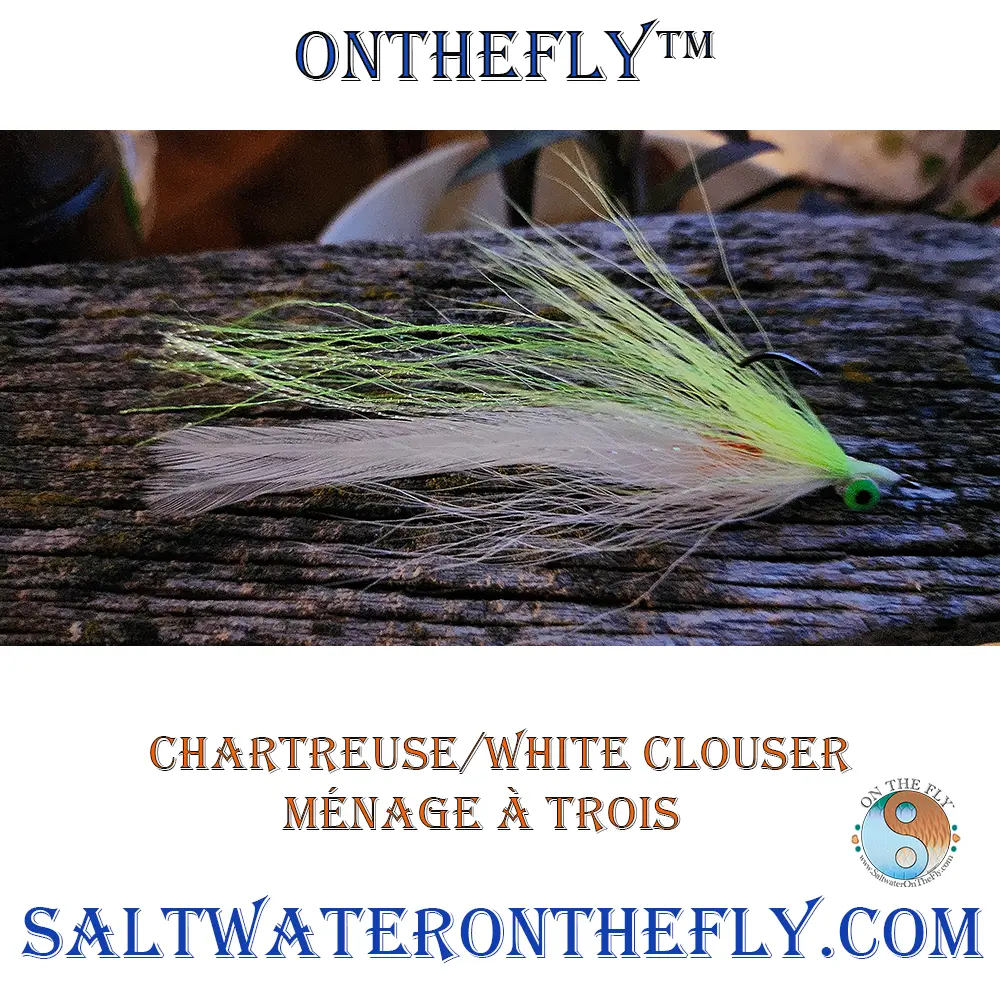
Fly Rods Up During Fall Run: Catch Them Coming & Going
Come fall another window opens—the return run back out to sea which offers incredible action too but requires patience as schools move more sporadically than in spring (but hey—who said fishing was easy?). Keep tabs on local reports since timing varies yearly depending on temperature drops triggering instincts telling them ‘it’s time’. Once underway though buckle up because autumn battles can rival any summer blockbuster—with less crowd competition bonus points.
Virginia’s coastal striped bass offer a fly-fishing experience like no other, especially during their spring and fall migrations. Hit the rivers in April and May to catch them heading upstream, or try your luck in the fall as they make their way back to sea. Pack your fly box with big streamers for these heavyweights, adapt techniques to conditions, and get ready for some of the most thrilling fishing around—with fewer crowds in autumn.
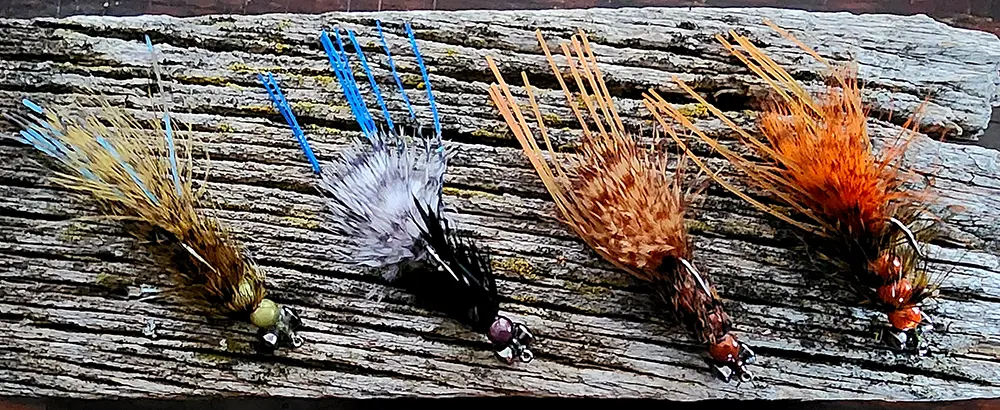
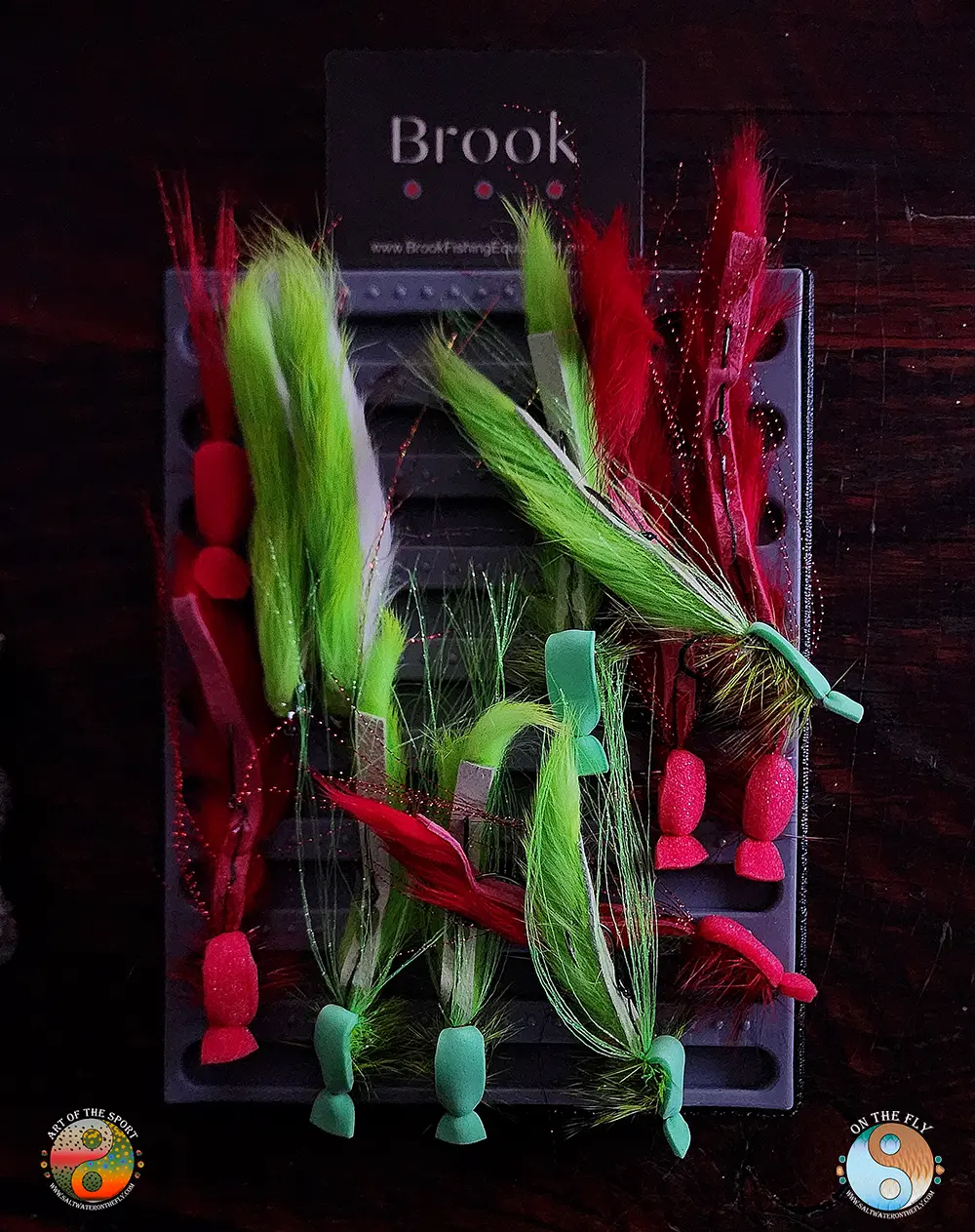
Outta the Box Fly Pad to keep flies at the ready. Gurgler can offer some great top water action. I like crawfish patterns for bass and trout. Fresh and Saltwater Flies Click Here.
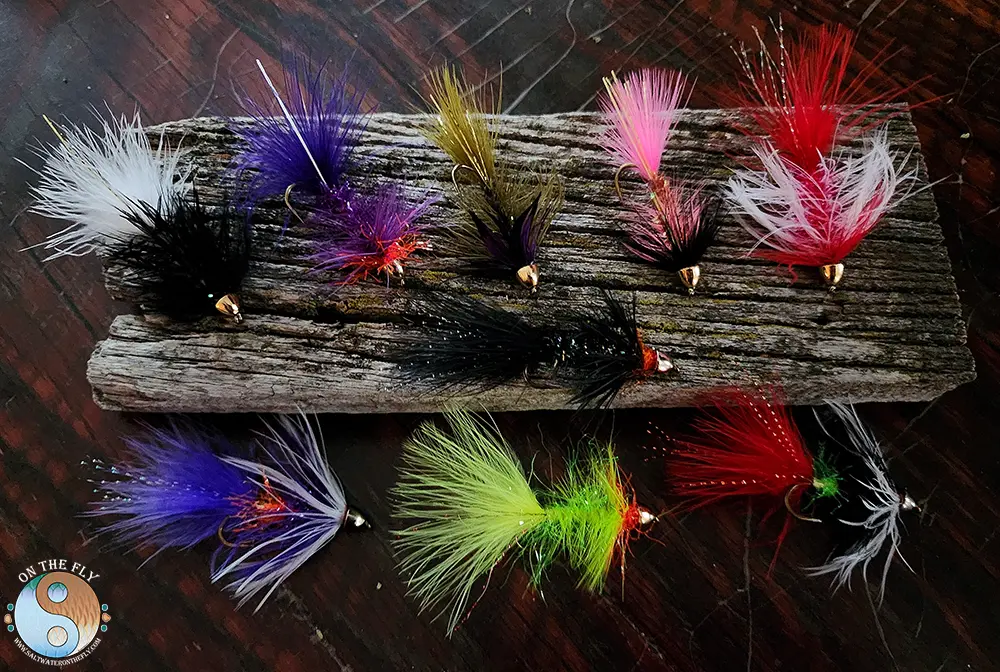
And don’t forget the save the day pattern. The Woolly Bugger
Essential Gear for Fly Fishing Across Virginia
Fly fishing in Virginia is like a dance, with each step demanding the right gear. The state’s waters brim with trout, bass, muskie, and coastal striped bass—all waiting to test your tackle box mettle.
Choosing Flies That Entice Virginian Game Fish
To match wits with Virginia’s game fish, you’ve got to think like them. Let’s talk flies first. You’ll want your fly rod rigged up with locals’ favorites that mimic what these fish feast on daily. Think mayflies or caddis when brook trout are on the menu in mountain streams or poppers for those explosive topwater strikes from smallmouth bass along the James River.
In Giles County’s wild waters or beneath the surface of Hungry Mother Lake, stock your fly boxes based on seasons and hatches—terrestrials during summer months can be particularly effective as well as streamers that play into predatory instincts of muskies lurking in river bends.
Tailoring Your Fly Rod Setup for Each Adventure
The versatile angler knows one size doesn’t fit all when it comes to rods. For tight casting spots along Blue Ridge Parkway streams where brookies hide out, a shorter 7-foot fly rod in a 1 or 2 weight, gives you precision without snagging every leafy overhead branch.
Moving onto larger water bodies such as Smith Mountain Lake? Here’s where an 8-10 foot fly rod lets you reach further distances and manage bigger lures for stripers known to grow trophy-sized around boat ramps dotted across this vast reservoir.
Fly Fishing Equipment: More Than Just A Fly Reel And Fly Line
Your reel should sing harmony with your line weight—it’s not just about having something that spins nicely. If targeting smaller freshwater fish like spotted bass or chain pickerel go light; but if it’s striper fishing off Walker’s Dam expect heavier gears able to withstand saltwater battles against these strong swimmers making tidal rivers their home turf at times.
Virginia Marine Resources Commission suggests balancing equipment choices by considering both target species and fishing area conditions.
Honing In On Fly Fishing: The Art Of Selection And Presentation
Talk with locals and do your home on your destination waters. Know what bugs are hatching. Do you know when the lake turns over? What baitfish live at what level of the water column.
To stay up-to-date with the latest rules and regulations regarding wildlife resources, make sure to visit our Department’s regulations page.
It’s packed with all the info you’ll need to know before heading out into nature. Whether it’s for fishing, hunting, or just enjoying the great outdoors, we’ve got you covered.
Virginia’s waters are full of diverse fish, so pack your tackle box with a variety of flies to mimic local prey and gear up with the right rod length for precision or reach. Match your reel to line weight for the best experience—whether it’s light freshwater action or heavy saltwater combat.
Best Practices for Catch-and-Release Fishing
Fly fishers in Virginia know the drill: you hook a shimmering trout or feisty bass, reel it in with bated breath, and then comes the moment of truth—catch and release. Doing this right is like a dance between angler and fish, ensuring each partner parts ways unharmed.
Wetting Your Hands Before Handling Fish
You’ve heard it before but let me paint it clearer than a mountain stream: always wet your hands before touching your catch. This simple act maintains the protective slime coat on fish that shields them from infection and disease. Think of it as handling someone else’s baby—you’d want to make sure you’re clean first, right? That same level of care applies here.
This isn’t just good karma; Virginia’s Department of Wildlife Resources echoes this sentiment by promoting gentle handling practices among anglers across our rich fishing tapestry—from smallmouth bass haunts along the James River to brook trout sanctuaries nestled within Blue Ridge parkways.
Giving Fish A Proper Send-off After The Fight
The battle may be won but there’s still an art to setting your adversary free properly. It starts with minimizing air exposure—like avoiding sunburn after a day at Chesapeake Bay beach by staying under an umbrella. Keep those gills submerged. If they can’t breathe underwater any better than we can hold our breath outside it—we owe them quick respite back into their liquid world.
If that catch took more out of them than expected—a muscular muskie from Giles County waters perhaps—they might need some extra TLC before swimming off. Gently cradle your trophy against the current until they give that tail kick signal saying “I’m good to go.” Just remember how crucial these moments are; reviving one successfully released gamefish contributes immeasurably towards maintaining thriving populations for future fly fishing experiences.
Mindful Hook Removal To Preserve Our Aquatic Friends
No one likes going to the doctor only to leave with stitches—it’s similar for fish when hooks tear at their mouths unnecessarily harshly because someone was too hasty during removal. Using barbless hooks makes extraction smoother faster while reducing injury risks significantly which ultimately helps maintain healthy stocks particularly important given striped bass peaks spring spawning migrations through tidal rivers leading upriver beyond Walker’s Dam boundaries.
Sometimes, even the most cautious anglers can find themselves in challenging situations where hook points get stuck in hard-to-reach areas. In these moments, tools like hemostats are essential. They offer precise control and allow for gentle maneuvers when dealing with sensitive spots inside a fish’s mouth. Using them helps make sure that we can release our finned catches safely back into their watery homes.
Wet your hands before handling fish to protect their health and give them a gentle release back into the water after an exhilarating fight. Use barbless hooks for easier removal, safeguarding our aquatic friends for future anglers.
Navigating Virginia’s Top Fly Fishing Destinations
Whether you’re itching to cast for trout in the Blue Ridge or on the hunt for that trophy fish along the Chesapeake Bay, this state has an incredible variety of fishing spots.
Casting Lines at Smith Mountain Lake: A Hub for Diverse Species
Famed for clarity that rivals distilled water, Smith Mountain Lake calls out to anglers looking to snag not just any striped bass but perhaps their personal best. But don’t let these sleek beauties distract you from other residents like spotted bass and chain pickerel who are also vying for your flies. The lake’s diverse ecosystem means there’s never a dull moment on your line.
Tucked away near Roanoke River lies another gem—the scenic Upper James River—where smallmouth bass reign supreme. With access points generously dotted along its banks, launching into this freshwater fray is as easy as finding a boat ramp.
The Lure of Tidal Rivers: Striper Fishing Adventures Await
If you thought all tidal rivers were created equal, wait until you’ve felt the pull of a striper during peak season. When spring rolls around, so do schools upon schools of coastal striped bass making their way through Virginia’s estuaries—a spectacle that even seasoned fishermen can hardly resist recounting by heart. Buggs Island Lake serves up similar thrills where casting under walkers dam could mean reeling in more than just stories.
A Taste of Appalachian Serenity: Brook Trout and Beyond
In the shadows of Appalachians lie tranquil waters home to brook trout which make up 80% percent wild population hereabouts; it seems only fitting they’ve become something akin royalty amongst local game fish species thus earning them top billing Giles County Sandy River especially when hatches coincide with hungry mother nature her Laurel Creek domain. Not far off Shenandoah National Park provides perfect backdrop some serious rainbow stocking action because let us be honest nothing beats sight majestic peaks while waiting bite…
Fishing Company Secrets Revealed:
- To really feel part Monongahela National Forest grab rod head over Greenbrier River—you’ll thank me later.
- Looking epic day? Try New twist old favorite flathead catfish might surprise yet again find yourself walking trails next Holston thinking about one got away…unless didn’t course then pat back my friend well done indeed.
- But sometimes, the simple pleasures are right in our own backyard. Take Big Stony Creek and North Fork as examples—these wide-open spaces offer fishing experiences that you’ll want to return to month after month, year after year.
Virginia’s fly fishing is unmatched with its mountain streams and coastal rivers—there’s a spot for every angler. Smith Mountain Lake shines with diverse species, while the Upper James River is smallmouth bass territory. Get ready for striper action in tidal rivers during spring and don’t miss out on Appalachian brook trout in serene waters. Local secrets? Hit Greenbrier River or chase flathead catfish near Holston trails.
Regulations You Need to Know Before You Fly Fish Virginia
Virginia’s waters are teeming with fish that’ll make your reel scream, but before you set out for an epic day on the water, it’s critical to know the rules of the game. Staying on top of current fishing regulations isn’t just about avoiding a chat with the local warden—it’s about respecting our aquatic playgrounds and keeping them flush with those finned beauties.
Understanding Special Regulations on Certain Bodies of Water
Gearing up for some fly action? Hold your horses. Some spots in Virginia have their own set of special regulations that could affect your plans. Whether it’s seasonal closures that give fish a breather during spawning or gear restrictions designed to keep populations healthy, these rules are there for good reason. And let’s be real—who wants to show up at a pristine river only to find out it’s off-limits?
If you’re eyeing department-owned lakes, ponds, streams or boat access sites for your next adventure, make sure you’re clued in on any curveballs they might throw at you—like dam regulations which can vary widely across different locations. Knowledge is power here; not knowing could mean missing out on some prime casting time.
Fishing Licenses: Your Ticket To The Great Outdoors
A fishing license is like getting backstage passes—you need one if you want access to all the action. They help manage fisheries and maintain quality habitats so we can all enjoy angling antics year after year. Grabbing yours is as easy as clicking over here, where everything from daily permits to annual licenses awaits eager anglers ready for their next freshwater conquest or saltwater sortie.
Dam Regulations: Navigating Restricted Zones With Ease
Dams may offer hotspots brimming with bites but remember—they come wrapped in red tape sometimes thicker than monofilament line. Always check if specific dam areas put limitations around when and how you can cast away because nothing ruins a trip faster than realizing too late that half your favorite stream has more no-go signs than an exclusive golf club.
Licenses by Type – Are You Covered?
- An annual license gives die-hard enthusiasts endless days chasing tail—for fish I mean.
- The short-term option works wonders if spontaneity strikes and suddenly there’s room in tomorrow morning’s schedule.
- You’ve got specialty tags too—for trout fans or coastal striper seekers—making sure whatever bendy rod thrills float your boat (or don’t), they’ve got it covered.
Before you hit Virginia’s waters, know the rules—fishing regulations and special area laws keep our fish thriving and your trip trouble-free. Always check for updates.
Don’t forget to grab your fishing license. It’s your must-have pass for access to all the aquatic action, with options from daily permits to annual adventures.
Dams are tempting but tricky; make sure you’re clear on any restrictions before casting in these potential hotspots to avoid disappointment.
Mastering Fly Fishing Techniques Tailored to Fly Fish Virginia
Fly fishing in Virginia isn’t just about tossing a line and hoping for the best. It’s an art form, where each cast is a brushstroke on the water’s canvas. To truly excel, you’ll want to sharpen your skills with advanced techniques that are as diverse as Virginia’s aquatic environments.
Streamer Tactics For Targeting Predatory Fish Like Muskie And Bass
In the shadowy depths of rivers like the New and Shenandoah, muskie lurk like underwater mob bosses waiting for an easy meal. Here’s where streamer tactics come into play. Big flies mimic wounded baitfish—an irresistible snack for these freshwater titans.
And let’s not forget about our sharp-toothed friends, chain pickerel and white bass. They’re not ones to shy away from a well-placed streamer either—especially when it flashes through their territory like lightning across storm clouds.
To really hook these game fish, imagine you’re orchestrating a ballet under water; it’s all about rhythm and flow. Cast near logs or rock structures where predators hide out then strip back with erratic twitches that scream “Eat me if you can.” Remember though, these fish aren’t gullible—they’ll test your resolve faster than hot coffee on a cold morning trek up Blue Ridge Parkway.
The Ethical Fly Fisher: Promoting Responsible Fishing Practices
Becoming one with nature means respecting her rules—and that includes playing by ethical fishing practices while wading through Virginia’s waterscapes. Let’s talk catch-and-release because here in Old Dominion we’re more than anglers; we’re guardians of our aquatic playgrounds.
Catch-and-release starts with wetting your hands before handling those slippery trophies so their protective slime coat stays intact—it works better than any ‘slip n slide’ could ever dream. When reviving them before release think slow dance rather than rock concert encore—a gentle cradle in moving water will send them off stronger into river currents or lake havens alike.
Virginia Department of Wildlife Resources has laid down guidelines akin to recipes for sustainable fisheries stewards (minus actual cooking). Make sure every fly outing ends as responsibly as it begins.
Navigating Virginia’s Top Fly Fishing Destinations
A treasure map isn’t necessary when looking for top-notch fly fishing spots throughout this state—we’ve got plenty marked X already. From Smith Mountain Lake renowned clear waters harboring striped bass aplenty to hidden gems along Upper James River trail ripe with trophy catches awaiting savvy anglers who know how tidal rivers work their magic during migrations seasons…
Virginia fly fishing is an art, demanding you master diverse techniques for different fish. Use streamers in the shadows for muskie and bass; dance your line to entice them. Respect nature with ethical practices like catch-and-release, ensuring our water’s future. Find prime spots across Virginia, where clear waters and tidal rivers promise rich rewards.
Mastering Fly Fishing Techniques Tailored to Virginian Waters
Whether you’re whipping streamers into the current or sight casting along briny coastlines, every cast is a brush stroke on Virginia’s aquatic canvas.
Streamer Tactics For Targeting Predatory Fish Like Muskie And Bass
The rivers of Virginia are playgrounds for predatory fish such as muskie, chain pickerel, and white bass. Streamer fishing here can feel like a strategic game of chess where anglers match wits with these underwater adversaries. When going after muskie—a beast often found patrolling the New River—size matters. Your fly should mimic their prey which means bigger is better if you want to catch this apex predator’s eye.
Moving water brings another set of challenges and opportunities when chasing smallmouth bass through stretches like those in Giles County or James River’s rocky bends. Think ambush points near structure where these freshwater gladiators lie in wait. A well-placed streamer presented with stealth can provoke explosive takes from both smallmouth and white bass alike.
In river fly tactics, remember that timing is everything because 80% of wild trout population thrives here too—brook trout being our native pride-and-joy. These fish demand subtlety so your approach needs some serious ninja skills: think less about brute force and more about perfect placement alongside logs or undercuts where they hide out during midday sun.
Sight Casting Along Coastlines For Striped Bass And Other Saltwater Species
If saltwater species are more your style then head down to Chesapeake Bay come springtime when striped bass make their spawning pilgrimage upstream into tidal rivers—a true spectacle for any angler worth his salt (pun intended). Sight casting requires sharp eyes and even sharper reflexes; spot ’em first before laying down that delicate presentation ahead of their path while avoiding spooking them off altogether—it’s akin to threading a needle on horseback at full gallop.
Alongside striper hunting grounds lies an array of other enticing targets such as speckled trout amidst grass flats or red drum cruising sandy bottoms looking for trouble—or flies. Adjust your gear accordingly because whether it’s Smith Mountain Lake’s clear depths offering diverse species including stripers again—or Laurel Creek providing prime access points—the right equipment will turn good days into great ones out there on the salty frontier.
Virginia Marine Resources Commission provides essential info so keep tabs there for hot spots but don’t forget about smaller bodies
Fly fishing in Virginia is an art that requires finesse, from mimicking prey with larger streamers for muskie to ninja-like subtlety for native brook trout. Hit the Chesapeake Bay for a sight casting spectacle as striped bass spawn, and tailor your gear for diverse species across both fresh and saltwater.
The Ethical Angler: Promoting Responsible Fishing Practices
Every time you set foot in Virginia’s lush waterways, whether it’s the bountiful Chesapeake Bay or the rippling currents of the James River, you’re not just an angler—you’re a steward of nature. Embracing ethical angling practices is about more than catch-and-release; it’s about preserving our aquatic playgrounds for generations to come.
Fishing with Foresight: Ensuring Tomorrow’s Trophy Fish
Picture this: You’re on Hungry Mother Lake, and there’s a tug on your line—a sign that one of Virginia’s game fish has taken a liking to your fly. But as much fun as it is to reel them in, making sure they swim away healthy is key. Wetting your hands before handling these beauties minimizes harm so they can grow into tomorrow’s trophy fish. It shows respect for creatures like muskie and bass who call these waters home.
A sustainable future also means knowing when enough’s enough—keeping only what you need ensures populations thrive. The red drum beating their way through tidal rivers and striped bass cruising by boat ramps aren’t just another day’s catch; they’re part of an intricate ecosystem we’ve got the privilege to be part of.
Gear Up Right: Tackle That Takes Care
Selecting gear isn’t just about what lands us the biggest striper fishing story at Walker’s Dam—it’s also choosing tackle that doesn’t leave lasting scars on our finned friends or their habitats. From using barbless hooks while navigating Smith Mountain Lake to picking up any stray lines along Roanoke River trails, every choice reflects back on us—the anglers—and shapes how others view our passion.
Besides being thoughtful with gear choices, supporting local fishing companies who prioritize sustainability strengthens community ties and boosts conservation efforts across Virginia—from Monongahela National Forest down through Blue Ridge Parkway locales where brook trout abound amidst Appalachia grandeur.
Navigate Nature Responsibly Along Virginian Water Trails
Sure-footedness isn’t reserved solely for hiking national forest paths but extends equally towards traversing river trails from Upper James down Stony Creek wayside stops. Sticking close by designated access points lessens environmental strain allowing flora alongside Giles County streams room to breathe without trampling from overeager boots eager for an excellent fishing spot off-the-beaten-path. This same caution should carry onto sandy river banks frequented by saltwater fish seekers too.
Catch-and-Release with Care
Virginia Department of Wildlife
The Virginia Department of Wildlife is dedicated to conserving and protecting the state’s natural resources. They manage wildlife populations, habitats, and offer educational programs aimed at fostering an appreciation for the environment. By doing so, they aim to balance human needs with those of nature.
Committed to sustainability and stewardship, this department works tirelessly to monitor ecosystems and implement conservation strategies. Their work not only preserves biodiversity but also benefits local communities by maintaining healthy environments that support recreation and tourism.
This commitment extends beyond just preserving landscapes; it includes a focus on engaging with residents through outreach initiatives that teach about Virginia’s diverse wildlife. So if you’re looking for information or want to get involved in protecting our natural heritage, reach out—the Virginia Department of Wildlife is your go-to resource.
Be an ethical angler in Virginia by practicing catch-and-release with care, using sustainable gear, and respecting wildlife to preserve our waterways for future generations.
FAQs in Relation to Fly Fish Virginia for Trout Bass Muskie and Coastal Striped Bass
Can you fly fish for striped bass?
Absolutely. Striped bass hit flies, especially during their spring and fall runs.
Can you catch striped bass in Fly Fish Virginia?
You sure can. Look for stripers in coastal rivers and the Chesapeake Bay area.
What is the state saltwater fish of Virginia?
The robust striped bass holds the title as Virginia’s state saltwater fish.
Conclusion of Fly Fish Virginia
So, you’re ready to fly fish Virginia for trout, bass, muskie and coastal striped bass. The waters here have spoken; they’ve shared their secrets of Appalachian brook trout in mountain streams and the mighty battles with smallmouths. They’ve whispered tales of stalking muskies through river bends and tracking stripers along the Chesapeake Bay.
Pack your gear with confidence now. Remember that a proper catch-and-release technique keeps those waterways thriving for years to come. Regulations are there to guide us—follow them as closely as you would your fly line on the James or New River.
Fishing is more than just landing trophy fish—it’s about respect for nature and understanding our place within it. Whether wading through Laurel Creek or casting from a boat ramp at Smith Mountain Lake, let every trip deepen that connection.
You came seeking knowledge; leave as an ambassador of conservation, armed with memories made under Virginian skies by day and stories told around campfires by night.
Fly Fish Another State or Country
Where is your next fly fishing excursion? A fly fishing tour of Italy or visit the island of Iceland for great fly fishing. Take an Alaskan Wilderness Float Trip.


